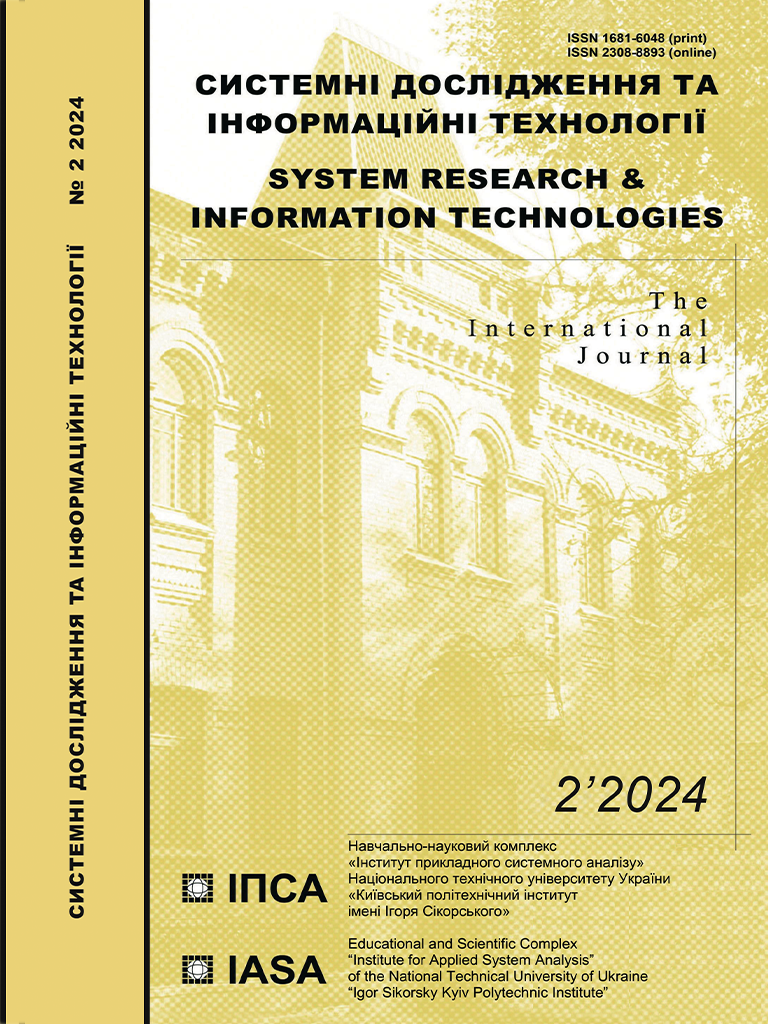Expansion of the mathematical apparatus of discrete-continuous networks for the automation of their synthesis procedures
DOI:
https://doi.org/10.20535/SRIT.2308-8893.2024.2.07Keywords:
Petri nets, system with controlled structure, discrete-continuous network, automatic synthesis of Petri netsAbstract
The paper deals with a model of an intelligent system related to the automatic synthesis of Petri nets and presents a certain stage of developing this model. The peculiarity of the extended mathematical apparatus is that it contains a combination of Petri net incidence matrices to represent various algorithms. This combination of matrices is part of the equations describing the logic control device of a complex system. Accordingly, the work also presents a well-known mathematical description of discrete-continuous systems with a controlled structure, which includes certain logical control devices. This mathematical description, based on means of discrete-continuous networks, is associated with the incidence matrix of the Petri net, which is formed as a result of a particular synthesis algorithm. At the same time, the formed Petri net represents the corresponding logical control algorithm that should ensure the effective functioning of the corresponding system. The final part of the work presents various structural schemes of logic-dynamic models of systems related to the automatic synthesis of Petri nets. Here, we determine the features of the advanced mathematical apparatus based on discrete-continuous networks to develop an intelligent system that forms logical control algorithms. It is also noted that such systems can be used to create certain control algorithms that ensure increased efficiency of the functioning of some objects in difficult and unpredictable conditions.
References
J.L. Peterson, Teorija setej Petri i modelirovanie sistem [Petri net theory and the modeling of systems]. M.: Mir, 1984, 264 p.
K. Jensen, G. Rozenberg, High-level Petri nets: theory and application. Springer Science & Business Media, 2012, 721 p. doi: 10.1007/978-3-642-84524-6
P.V. Skorodumov, “Analysis of future expansions of Petri networks,” Science and World, vol. 1, no. 10(14), pp. 66–68, 2014.
M.Z. Zgurovsky, V.A. Denisenko, Diskretno neprerivnie sistemi c upravlyaemoi strukturi [Discrete-continuous system with controlled structure]. Kyiv: Naukova dumka, 1998, 350 p.
Z. Yang, M. Blanke, “A unified approach to controllability analysis for hybrid control systems,” Nonlinear Analysis: Hybrid Systems, vol. 1, issue 2, pp. 212–222, 2007. doi: 10.1016/j.nahs.2006.08.002
M.A. Drighiciu, “Hybrid Petri nets: A framework for hybrid systems modeling,” 2017 International Conference on Electromechanical and Power Systems (SIELMEN) – IEEE, 2017, pp. 020–025. doi: 10.1109/SIELMEN.2017.8123285
F.N. Tsarev, A.A. Shalito, Primenenie geneticheskogo programmirovaniya dlya generacii avtomata v zadache ob “Umnom murave” [Application of genetic programming for automatic construction of an automaton in the problem of “intelligent ants”]. M.: Fizmatlit, 2007, pp. 590–597.
A.V. Aleksandrov, “Generacija konechnyh avtomatov dlja upravlenija model’ju bespilotnogo samoleta [Generation of state machine creation for unmanned airplane controlling],” Scientific and Technical Journal of Information Technologies, Mechanics and Optics, vol. 2(72), pp. 3–8, 2011.
A.A. Gurskij, A.E. Goncharenko, and A.V. Denisenko, “Generaciya seti Petri na baze sredstv diskretno-nepreryvnyh setej pri formirovanii algoritma avtomaticheskoj nastrojki koordiniruyushchej sistemy upravleniya [Petri net generation by means of the resource of the discrete-continuous nets in the algorithm formation for the self-tuning of the coordinating control system],” Electrotechnic and Computer Systems, no. 26(102), pp. 78–87, 2017.
D.W. He, B. Strege, H. Tolle, and A. Kusiak, “Decomposition in automatic generation of Petri nets for manufacturing system control and scheduling,” International Journal of Production Research, vol. 38, issue 6, pp. 1437–1457, 2000. doi: 10.1080/002075400188942
A.A. Gurskiy, A.V. Denisenko, “The automatic synthesis of Petri nets based on the functioning of artificial neural network,” Radio Electronics, Computer Science, Control, issue 2/2021, pp. 84–92, 2021. doi: 10.15588/1607-3274-2021-2-9
A. Denisenko, A. Gurskiy, “Information technology of visualization for technological processes for research modes of complex technological systems functioning,” System Research and Information Technologies, no. 2, pp. 74–83, 2021. doi: 10.20535/SRIT.2308-8893.2021.2.06

